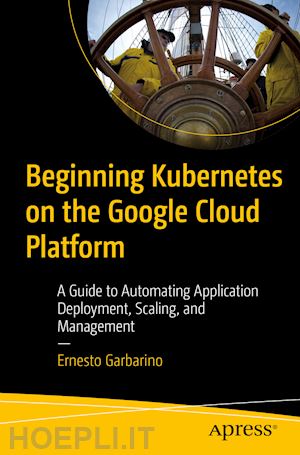
Questo prodotto usufruisce delle SPEDIZIONI GRATIS
selezionando l'opzione Corriere Veloce in fase di ordine.
Pagabile anche con Carta della cultura giovani e del merito, 18App Bonus Cultura e Carta del Docente
What You Will Learn
Who This Book Is For
Beginners with basic Linux admin and scripting skills (Bash and Python). Proficiency with Docker is not required as all examples in the book use off-the-shelf public images from Docker Hub.
Setting Up a Cluster
Listing Clusters
Deleting a Cluster
Getting Login Credentials
Installing Kubectl
Checking Kubectl Version
Using GCE Credentials
Clusters and Nodes
Nodes
Nodes’ Resource Consumption
Hello World Application
Chapter 2: Pods
The Fastest Way to Launch a Pod
Launching a Single Pod
Launching a Sigle Pod to Run a Command
Running a Pod Interactively
Interacting with an Existing Pod
Retrieving and Following Pod’s Logs
Interacting with a Pod’s TCP Port
Transferring Files From and To a Pod
Selecting a Pod’s Container
Troubleshooting Pods
Pod Manifests
Declaring Containers’ Network Ports
Setting Up the Container’s Environment
Overwriting The Container’s Command
Managing Containers’ CPU and RAM Requirements
Pod Volumes and Volume Mounts
External Volumes and Google Cloud Storage
Pod Health and Lifecycle
Namespaces
Labels
Annotations
Chapter 3: Deployments and Scaling
ReplicaSets
Our First Deployment
More on Listing Deployments
Deployments Manifests
Monitoring and Controlling a Deployment
Finding Out a Deployment’s ReplicaSets
Finding Out a ReplicaSet’s Pods
Deleting Deployments
Revision-Tracking vs Scaling-Only Deployments
Recreate DeploymentsRolling Update Deployments
The Pros and Cons of a Higher MaxSurge Value
The Pros and Cons of a High MaxUnavailable Value
Blue/Green Deployments
Summary of MaxSurge and MaxUnavailability Settings
Controlled Deployments
Rollout History
Rolling Back Deployments
The Horizontal Pod Autoscaler
Setting Up Autoscaling
Observing Autoscaling in Action
Scaling the Kubernetes Cluster Itself
Chapter 4: Service Discovery
Introduction
The Service Controller
Finding Pods’ IP Addresses
Accessing a Pod From Within Another Pod
Accessing Pod(s) From Within a LAN
Accessing Pod’s From The Internet
Listing All Running Services
Deleting a Service
Accessing Services in Different Namespaces
Exposing Services on a Different Port
Waiting for a Public IP Address To Be Assigned
Canary Releases
Canary Releases and Inconsistent Versions
Exposing Multiple Ports
Graceful Startup and ShutdownZero-Downtime Deployments
Pods’ Endpoints
Listing and Deleting Services
Chapter 5: ConfigMap and Secrets
Storing Configuration Properties in Kubernetes
Getting New Configuration Automatically
Picking Selected Properties From a ConfigMap
Passing ConfigMap’s values to a Pod’s Startup Arguments?
Updating a ConfigMap
Loading ConfigMap’s Properties From a File
Storing Large Text in a ConfigMap
Retrieving a Large File Stored in a ConfigMap
Live ConfigMap Updates
Storing Binary Data
Secrets
Difference Between ConfigMap and Secret Objects
Reading Properties From Secrets
Docker Registry Credentials
TLS Public Key Pair
Listing and Deleting ConfigMap and Secret Objects
Chapter 6: Jobs
One-off Process
Multiple Independent Processes
Multiple Coordinated Processes
Advanced Batch Scaling and Control
Waiting until a job completes
Timing out stuck jobs
Other Restart Policies
Managing and Deleted Jobs
Wrap-Up
Chapter 7: CronJobs
The Simplest Possible CronJob
Setting Up Recurring Tasks
Setting Up One-Off Tasks
Jobs History
Interacting with CronJob’s Jobs and Pods
Suspending a CronJob
Job Concurrency
Catching Up With Missed Sheduled Events
Management (Listing, Deleting and Suspending)
Chapter 8: DaemonSets
TCP-based Daemons
File System-based Daemons
Daemons that Run on Specific Nodes Only
Update Strategy
General Administration
Wrap Up
Chapter 9: StatefulSets
The Dumbest Key/Value Store In The World
Minimal StatefulSet Manifest
Sequential Pod Creation
Stable Network Identity
Headless Service
A Smart Client For a Dumb Key/Value StoreControlling The Creation and Termination of a Backing Store
Order of Pod Life Cycle Events
Implementing Graceful Shutdown using Pod Life Cycle Hooks
Observing StatefulSet Failures
Scaling Up and Down
Scaling Down
Scaling Up
Conclusions on Scaling Up and Down Operations
Proper Statefulness: Persistence to Disk
Persistent Volume Claims
Wrap Up
Ernesto Garbarino is a consultant specialized in the Digital, Cloud, and DevOps domains. His 20 year experience ranges from working with early start-ups and entrepreneurial organizations during the dot com era to senior consultancy work in blue chip industries including telecoms, logistics, and banking.











Il sito utilizza cookie ed altri strumenti di tracciamento che raccolgono informazioni dal dispositivo dell’utente. Oltre ai cookie tecnici ed analitici aggregati, strettamente necessari per il funzionamento di questo sito web, previo consenso dell’utente possono essere installati cookie di profilazione e marketing e cookie dei social media. Cliccando su “Accetto tutti i cookie” saranno attivate tutte le categorie di cookie. Per accettare solo deterninate categorie di cookie, cliccare invece su “Impostazioni cookie”. Chiudendo il banner o continuando a navigare saranno installati solo cookie tecnici. Per maggiori dettagli, consultare la Cookie Policy.